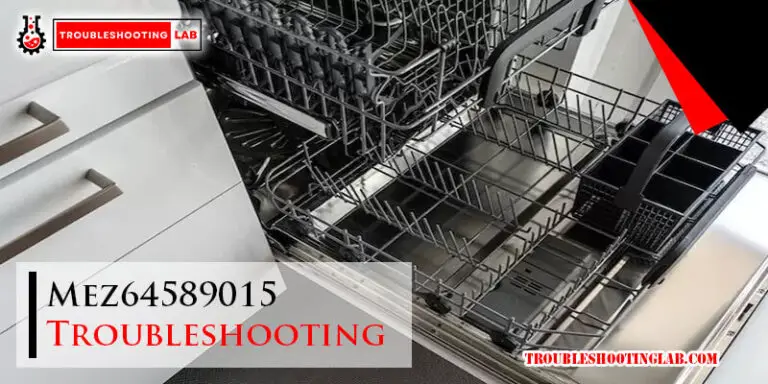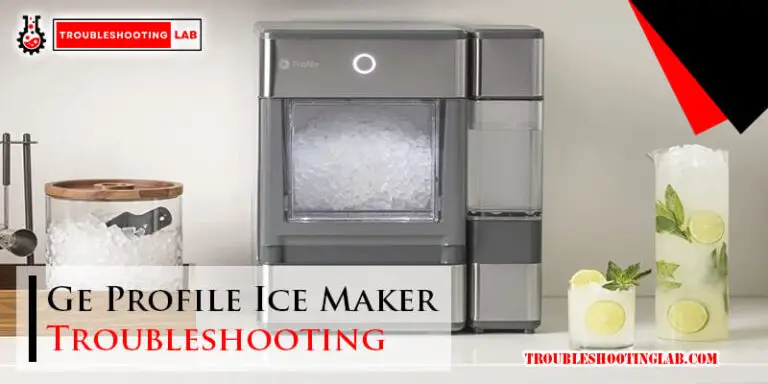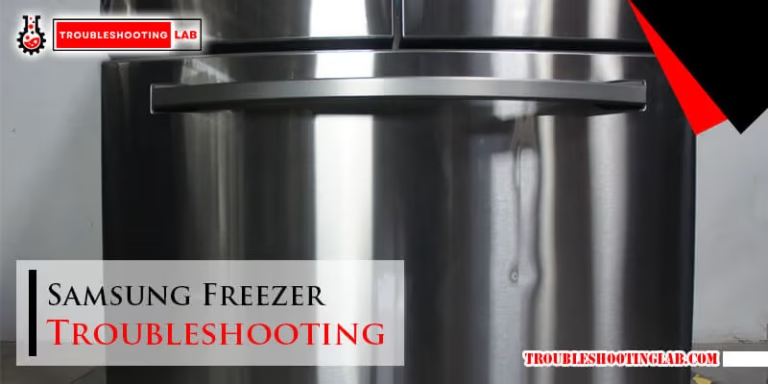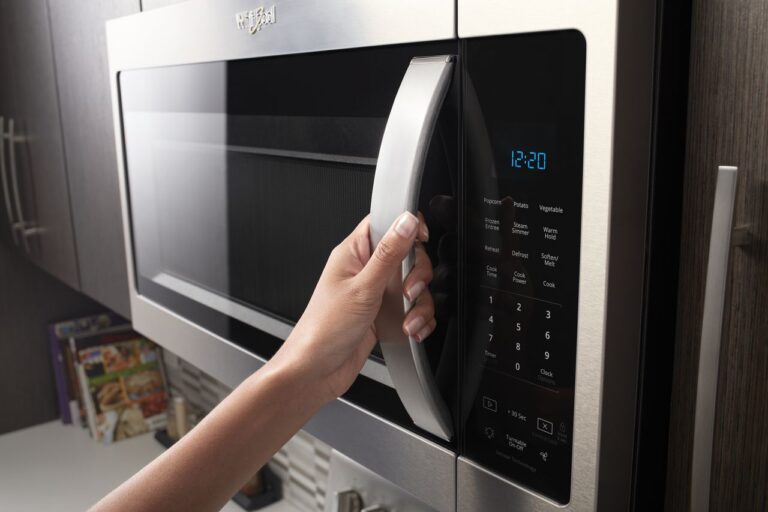Ge Refrigerator Ice Maker Troubleshooting: Expert Tips for Fixing Ice Maker Issues
If your GE refrigerator ice maker is not working, try checking the ice maker and its connector, and perform a diagnostic test. Adjusting the freezer temperature may also help.
Additionally, ensure that the water filter is not clogged and the water supply is not restricted. If the issue persists, consider replacing the water filter or checking for a faulty dispenser switch. Having a malfunctioning ice maker in your GE refrigerator can be frustrating, especially when you rely on ice for everyday use.
However, troubleshooting the issue can help you identify the cause and find a solution. This article will provide you with accurate and concise steps to troubleshoot your GE refrigerator ice maker. By following these steps, you can potentially fix the problem on your own and avoid the hassle of calling a technician. So, let’s dive into the troubleshooting process and get your ice maker up and running again.

Common Issues With Ge Refrigerator Ice Makers
GE refrigerator ice makers are convenient and provide a constant supply of ice for your day-to-day needs. However, like any other appliance, they can experience some common issues that may prevent them from making ice properly. In this section, we will discuss two common issues that you may encounter with your GE refrigerator ice maker: No Ice and Ice Maker Not Working After Filter Change. Let’s explore these issues and how you can troubleshoot them.
No Ice
If your GE refrigerator ice maker is not producing ice at all, there are a few potential causes that you can examine. Here are some troubleshooting steps you can take to resolve this issue:
- Check the water supply: Ensure that the water supply line to your refrigerator is properly connected and turned on. A kinked or blocked water supply line can prevent the ice maker from receiving water.
- Inspect the water filter: A clogged water filter can restrict water flow to the ice maker. Replace the water filter if it is dirty or has been in use for an extended period.
- Check the temperature settings: Ensure that the freezer temperature is set at the recommended level, usually between 0 and 5 degrees Fahrenheit. A warmer freezer temperature can affect ice production.
- Inspect the ice maker components: Check the ice maker assembly for any visible signs of damage or blockage. Remove any ice cubes or debris that may be obstructing the ice maker’s operation.
- Reset the ice maker: Sometimes, resetting the ice maker can help resolve the issue. Locate the ice maker switch and turn it off for a few seconds before turning it back on. This will reboot the ice maker and start a fresh ice-making cycle.
Ice Maker Not Working After Filter Change
If your GE refrigerator ice maker stops working shortly after changing the water filter, there could be a couple of reasons behind this issue. Here’s how you can troubleshoot it:
- Check filter installation: Ensure that the water filter is properly installed. Sometimes, an improperly installed filter can lead to restricted water flow and affect ice production.
- Reset the filter indicator: After changing the water filter, reset the filter indicator on your refrigerator’s control panel. This will help the ice maker recognize the new filter and resume normal operation.
- Wait for ice production: It may take some time for the ice maker to start producing ice after a filter change. Allow a few hours for the ice maker to fill up and start producing ice cubes.
- Inspect the water line: Ensure that there are no kinks or obstructions in the water supply line. A blocked water line can prevent the ice maker from receiving water, even after changing the filter.
By following these troubleshooting steps, you can address common issues with GE refrigerator ice makers and restore their functionality. If the problem persists or if you are unable to identify the cause, it is recommended to seek professional assistance to resolve the issue effectively.
Troubleshooting Tips For Ge Ice Makers
If you’re having trouble with your GE refrigerator’s ice maker, don’t worry – there are a few troubleshooting tips you can try before calling in a professional. These tips can help you diagnose and fix common issues that may be preventing your ice maker from working properly. Follow these steps to get your ice maker up and running again:
Check The Icemaker
The first thing you should do is check the ice maker itself to ensure that everything is functioning correctly. Start by checking the power switch – make sure it is turned on. Next, inspect the water supply valve and ensure that it is fully open. Sometimes, the water supply valve may get accidentally closed, which can prevent water from entering the ice maker. Lastly, check the ice bin to make sure that it is properly installed and positioned correctly.
Plug In The Icemaker Connector
If checking the ice maker doesn’t solve the issue, the next step is to check the icemaker connector. The icemaker connector is the electrical connection between the refrigerator and the ice maker. Sometimes, this connection can become loose or dislodged, which can cause the ice maker to stop working. To check the connector, simply unplug it from the refrigerator and plug it back in, ensuring that it is securely connected. This simple step can often resolve connectivity issues and get your ice maker back on track.
Run A Diagnostic Test
If the previous steps haven’t resolved the issue, running a diagnostic test on your GE ice maker may help pinpoint the problem. To run a diagnostic test, refer to your refrigerator’s user manual for specific instructions. Generally, the test involves pressing certain buttons or combinations of buttons on the control panel to initiate the test sequence. This will allow the refrigerator to perform a self-diagnosis and identify any underlying issues with the ice maker. Once the test is complete, the refrigerator will display an error code or provide further instructions for troubleshooting.
By following these troubleshooting tips, you can often resolve common issues with your GE refrigerator’s ice maker without the need for professional assistance. Checking the ice maker, ensuring a secure connection, and running a diagnostic test can help you identify and fix the problem, getting your ice maker back to its full functionality.
Possible Causes And Solutions
Having trouble with your GE refrigerator ice maker? There could be several causes, such as a clogged water filter or a faulty dispenser switch. Fortunately, troubleshooting steps like resetting the ice maker or checking the water supply can help resolve the issue and get your ice maker working again.
Water Filter Needs Replacing
If your GE refrigerator ice maker is not working properly, one possible cause could be a clogged or dirty water filter. Over time, the water filter in your refrigerator can become filled with sediment and contaminants, leading to reduced water flow and ice production. To troubleshoot this issue, follow these steps:
- Locate the water filter in your refrigerator. The exact location may vary depending on the model, so refer to your owner’s manual for guidance.
- Remove the water filter from its housing. This can usually be done by twisting or pulling the filter.
- Inspect the filter for any signs of clogging or discoloration. If the filter appears dirty or has been in use for longer than the recommended time, it is likely in need of replacement.
- Purchase a new water filter that is compatible with your specific refrigerator model. You can usually find replacement filters at your local home improvement or appliance store.
- Install the new water filter by following the manufacturer’s instructions. Make sure it is properly seated and securely in place.
- After replacing the water filter, allow the refrigerator to run for a few hours to flush out any air or impurities that may have been introduced during the installation process.
Once the new water filter is installed and the refrigerator has had time to flush out, check if the ice maker is now working properly. If not, it may be necessary to explore other possible causes and solutions.
Faulty Dispenser Switch
If your GE refrigerator ice maker is still not producing ice after replacing the water filter, another potential culprit could be a faulty dispenser switch. The dispenser switch is responsible for activating the ice dispenser and initiating the ice-making process. To troubleshoot this issue, follow these steps:
- Locate the dispenser switch on your refrigerator. This is typically located near the ice dispenser area.
- Check if the dispenser switch is stuck or not functioning properly. Press and release the switch a few times to see if it engages and disengages smoothly.
- Inspect the switch for any visible damage or loose connections. If there are any issues with the switch, it may need to be replaced.
- Contact GE customer support or a qualified technician for assistance with replacing the dispenser switch. They can provide guidance on obtaining a replacement switch and safely installing it.
After replacing the dispenser switch, test the ice maker to see if it is now working correctly. If the problem persists, there may be another underlying issue causing the ice maker malfunction.
Ice Tray Thermostat Issue
If your GE refrigerator ice maker continues to not make ice even after addressing the water filter and dispenser switch, there may be a problem with the ice tray thermostat. The ice tray thermostat is responsible for monitoring the temperature of the ice tray and signaling the ice maker to harvest the ice once it has frozen. Follow these steps to further troubleshoot this issue:
- Locate the ice tray thermostat. This is usually situated near or within the ice maker assembly.
- Inspect the thermostat for any visible damage or signs of malfunction. Look for loose connections, frayed wires, or corrosion.
- If the ice tray thermostat appears to be faulty, it may need to be replaced. Contact GE customer support or a professional technician to obtain a replacement thermostat and for assistance with installation.
- After replacing the ice tray thermostat, allow the refrigerator to run for a few hours to see if the ice maker begins producing ice. If not, there may be another underlying issue that requires further diagnosis.
Resetting A Ge Ice Maker
To reset a GE ice maker, locate the ice maker switch on the control panel or inside the freezer compartment and turn it off. Wait a few seconds before turning it back on to allow the ice maker to reboot and start fresh.
Turn Off The Ice Maker
To reset a GE ice maker, the first step is to turn it off. Locate the ice maker switch, which is typically found on the control panel or inside the freezer compartment. Switch it off, and give it a few seconds to fully power down. This allows the ice maker to reboot and start fresh.
Wait And Turn It Back On
After turning off the ice maker, the next step is to wait for a moment before turning it back on. This short pause allows any residual power to dissipate and ensures a clean reset. After a few seconds, switch the ice maker back on and wait for it to power up again. Keep in mind that it may take a few minutes for the ice maker to start functioning properly.
Resetting a GE ice maker is a straightforward process that can help resolve common issues. By following these steps, you can effectively reboot your ice maker and potentially solve any performance problems it may be experiencing.
Professional Assistance And Resources
If you’re facing issues with your GE refrigerator ice maker and you’ve tried troubleshooting on your own without success, don’t worry. There are professional assistance and resources available to help you resolve the problem. Whether it’s contacting a GE appliance repair technician or seeking answers in online forums and communities, these options can provide you with the guidance and support you need. Let’s take a closer look at each of these options:
Contact A Ge Appliance Repair Technician
If you’ve exhausted all your troubleshooting options and still can’t get your GE refrigerator ice maker to work properly, it may be time to seek the help of a professional. A GE appliance repair technician is trained and experienced in diagnosing and fixing issues specifically with GE appliances. They have the knowledge and tools required to accurately identify the problem and provide you with the necessary solutions. To schedule a repair appointment, you can visit the official GE Appliances website or call their customer service hotline. When contacting a technician, make sure to provide them with specific details about the issue you’re experiencing, such as the model number of your refrigerator and a description of the problem.
Online Forums And Communities
If you prefer a more DIY approach or want to gather more information before contacting a professional, online forums and communities can be a valuable resource. These platforms provide a space for refrigerator owners, DIY enthusiasts, and experts to share their knowledge, experiences, and troubleshooting tips. You can find dedicated forums and communities focused on appliance repairs, including GE refrigerators, where users discuss common issues and solutions. By participating in these online discussions, you can learn from others who have faced similar problems and potentially find the answers you’re looking for. Keep in mind that while online forums can provide useful insights, it’s important to approach the information with caution and verify the credibility of the sources.
Frequently Asked Questions
Why Is My Ge Refrigerator Not Producing Ice?
If your GE refrigerator is not producing ice, it could be due to a clogged water filter or a restricted water supply. First, try changing the water filter. If the issue persists, check for a saddle valve or a kinked water supply line.
Adjusting the freezer temperature slightly lower may also help.
How Do I Reset My Ge Refrigerator Ice Maker?
To reset your GE refrigerator ice maker, locate the ice maker switch and turn it off. Wait a few seconds and turn it back on. This will reboot the ice maker and start fresh.
Why Is My Ice Maker Not Making Ice But Water Works?
If your ice maker is not making ice but water works, it could be due to a clogged water filter or a restricted water supply. Start by changing the water filter and checking for a saddle valve or a kinked water supply line. Adjusting the freezer temperature may also help.
Why Is My Refrigerator Not Making Ice?
If your refrigerator is not making ice, it could be due to a clogged water filter or a restricted water supply. Start by changing the water filter and checking for a saddle valve, a partially turned-on water valve, or a kinked water supply line.
Adjusting the freezer temperature may also help if it’s too warm.
Why Is My Ge Ice Maker Not Working Properly?
Possible reasons for a malfunctioning GE ice maker include a clogged water filter, restricted water supply, or a faulty dispenser switch.
Conclusion
Troubleshooting your GE refrigerator ice maker can be a simple process with the right steps. By checking the icemaker, diagnostic tests, temperature settings, water filter, and cleaning the ice bin, you can address common issues. Remember to reset the ice maker if necessary and consider checking for any blockages that may be hindering its functionality.
With these troubleshooting techniques, you can get your ice maker back up and running efficiently in no time.






